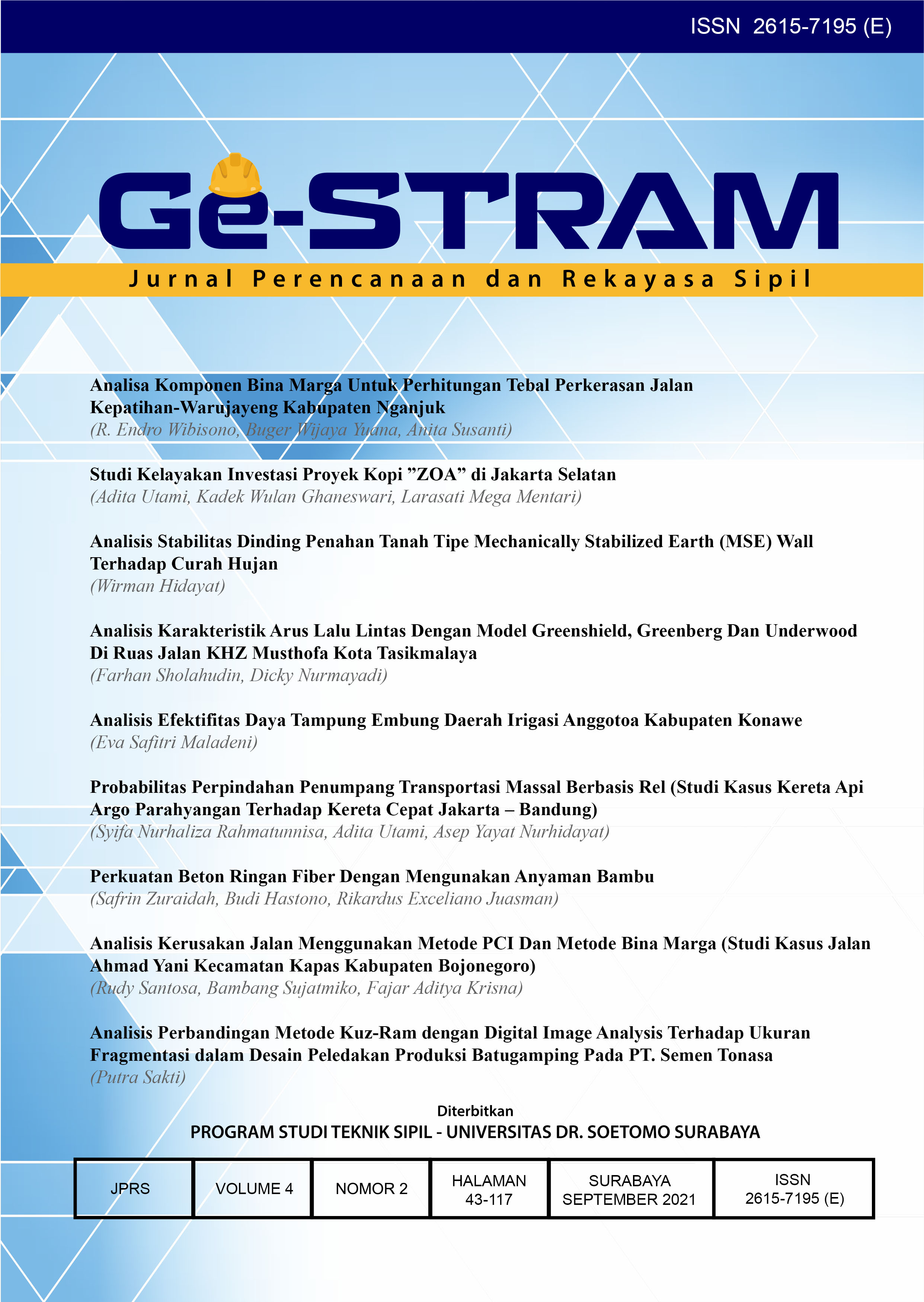Analisis Efektifitas Daya Tampung Embung Daerah Irigasi Anggotoa Kabupaten Konawe
 Abstract views: 181
,
Abstract views: 181
,
 PDF downloads: 379
PDF downloads: 379
Abstract
Water is very important in an irrigation area. In the growth of plants such as rice, they really need an adequate amount of water, so there is a need for research on effectiveness in terms of water requirements and in terms of water availability in irrigation buildings such as reservoirs. The purpose of this study was to determine the level of effectiveness of the availability of water in Embung Anggotoa in supplying water needs in the fields of Kukuluri Village. In this study, a modified Penman method was used to calculate the level of water use by plants, then calculated the need for clean water in the fields and then compared with the availability of water in the fields. the member pond. In analyzing the availability of water in the Anggotoa reservoir, a minimum discharge calculation is used using the Rational method. The results of the analysis of the need for clean water in the fields based on effective rainfall data and climatological data analyzed resulted in the water demand in the fields of 10.4605 mm/day/ha, then multiplied by the land area to determine the overall discharge required in Kukuluri rice fields with a land area of ​​95 ha. then the result is 993.7475 mm3/day. The results of the analysis of the minimum discharge in the upstream of the Anggotoa Reservoir based on rainfall data using the Rational method for a return period of 2 years = 61.198 m3/s, a return period of 5 years = 74,899 m3/s, a return period of 10 years = 87,686m3/s, a return period of 20 years = 100.930 m3/s, return period of 25 years = 105.041m3/s, return period of 50 years = 117.828, and return period of 100 years = 130.616 m3/s. Based on the results of the analysis of the flow of water availability, it shows that the capacity of the Anggotoa reservoir is still effective in meeting the water needs of the Kukuluri rice fields, the current accommodated discharge reaches 99405 m3 from the initial planning of 100000 m3.
References
Bardhan, Mochamad, 2013, Irigasi, Penerbit Graha Ilmu, Yogyakarta.
Bagiawan, A, 2013, Perhitungan Kebutuhan Kapasitas Tampung Bagi Rencana Pengembangan Areal Layanan Irigasi Dari Bendung Perjaya – Sumatera Selatan Dengan Metode Numerik Dan “Sequent Peakâ€, Jurnal irigasi vol 8 No 1 Mei 2013
Lakebo, M, 2015, Tugas akhir study Evaluasi Debit Air Di hulu Bendung Amonggedo, Universitas Lakidende.
Murtono,T, dkk, 2013, Zonasi Imbuhan Air Tanah Pada Daerah Aliran Sungai Lahumbuti Sulawesi Tenggara, Jurnal Geosains Vol 09 no. 2 2013.
Putri dkk. 2015. Evaluasi Kinerja Jaringan Irigasi Jragun Kabupaten Demak. Jurnal teknik pengairan Vol 6 No.1 Mei 2015 Hal. 66-75
Soemarto CD. 1986. Hidrologi Teknik. Penerbit Erlangga. Jakarta
Sosrodarsono S dan Taekda K. 1985. Hidrologi untuk pengairan. PT Pradnya paramita. Jakarta
Soedibyo. 1988. Teknik Bendungan. PT Pradnya paramita. Jakarta
Sutyas A dan Zeuba. 2011. Menentukan Kapasitas Tampungan Embung Ledok Di Kabupaten Gunung Kidul. Majalah Ilmiah UKRIM Edisi 2/th XVI/2011
Copyright (c) 2021 eva safitri maladeni

This work is licensed under a Creative Commons Attribution-ShareAlike 4.0 International License.
Authors who publish with this journal agree to the following terms:
- Authors retain copyright and grant the journal right of first publication with the work simultaneously licensed under a Creative Commons Attribution-ShareAlike 4.0 International License that allows others to share the work with an acknowledgement of the work's authorship and initial publication in this journal.
- Authors are able to enter into separate, additional contractual arrangements for the non-exclusive distribution of the journal's published version of the work (e.g., post it to an institutional repository or publish it in a book), with an acknowledgement of its initial publication in this journal.
- Authors are permitted and encouraged to post their work online (e.g., in institutional repositories or on their website) prior to and during the submission process, as it can lead to productive exchanges, as well as earlier and greater citation of published work (See The Effect of Open Access).

This work is licensed under a Creative Commons Attribution-ShareAlike 4.0 International License.















